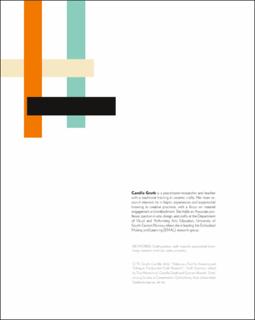Video as a Tool for Knowing and Telling in Practice-led Craft Research
Chapter, Peer reviewed
Published version
Permanent lenke
https://hdl.handle.net/11250/3022834Utgivelsesdato
2022Metadata
Vis full innførselSamlinger
- Institutt for estetiske fag [92]
- Publikasjoner fra CRIStin [3623]
Originalversjon
Groth, C. (2022). Video as a Tool for Knowing and Telling in Practice-led Craft Research. I T. Westerlund, C. Groth & G. Almevik (Red.), Craft Sciences (s. 48-66). Acta Universitatis Gothenburgensis.Sammendrag
As craft practices have been taken up in academia, practitioner-researchers meet the challenge of articulating experiential knowledge of their practice. This position asks the researcher to first document and make sense of the experience and knowledge residing in their body-based craft practice, as well as transforming this experience into a format that is communicable to a wider audience. Video can be used as a tool in accessing this experiential knowledge, as well as in disseminating it. Outside the academic field, video is used extensively in online tutorials and presentations of craft-related knowledge and techniques. This chapter explores aspects of researching and disseminating experiential knowledge through an example of ceramic practice. It further gives suggestions on how video can be a useful tool to revisit experiences when used as an autoethnographic re-call of the situation of practicing. Video documentation further enables a slow and more detailed analysis of the events, that are often too rich in content to be noted in the situation of practicing the craft. Video recordings show the context of the situation and the multiple overlapping events and details that words may not capture. In addition, video clips in presentations of craft research have the ability to awaken the audience’s possible previous experiences of similar events and thus bring about an illusion of a multimodal experience that point to the more implicit aspects of the situation. In the advent of online journals, there are now also possibilities to publish video recorded material as part of a research article, thus allowing for the implicit aspects of the practice to reach a wider audience. This chapter thus suggests the use of video in three aspects of craft research: 1) in documentation of experiential knowledge and events, 2) in the reflection on this knowledge and as an aid in accessing it, and 3) in the communication of the more implicit aspects of experiential knowledge.

